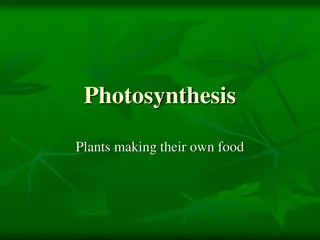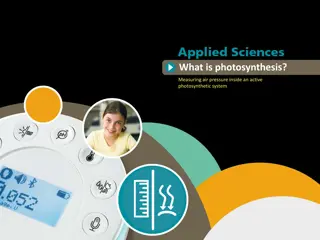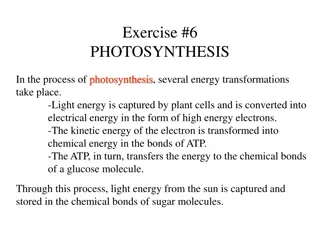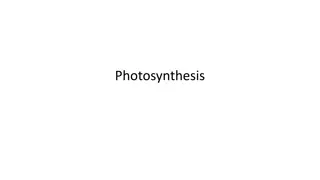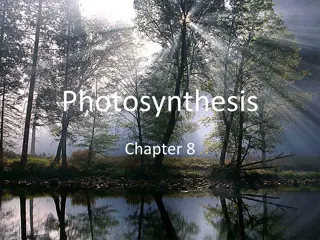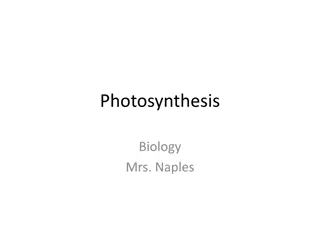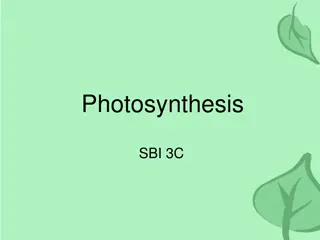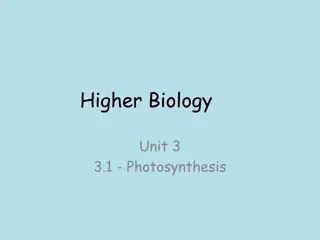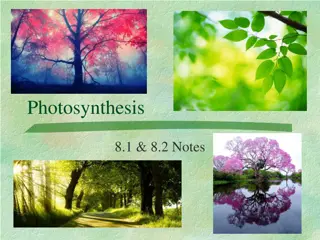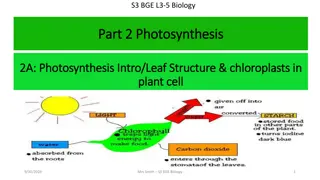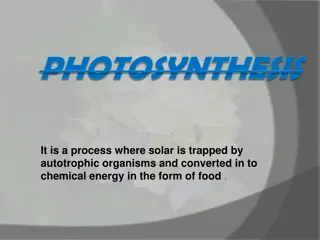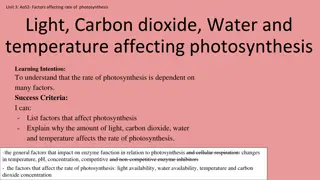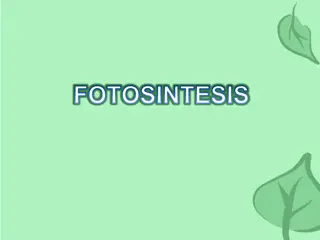Understanding Photosynthesis: A Vital Process in Biology
Photosynthesis is a fundamental process in biology where plants, algae, and certain bacteria harness sunlight to produce energy-rich compounds. This energy flows through food chains, ultimately sustaining all life forms on Earth. Explore the significance of photosynthesis in ecosystems and its role in providing essential nutrients for various organisms.
Download Presentation

Please find below an Image/Link to download the presentation.
The content on the website is provided AS IS for your information and personal use only. It may not be sold, licensed, or shared on other websites without obtaining consent from the author. Download presentation by click this link. If you encounter any issues during the download, it is possible that the publisher has removed the file from their server.
E N D
Presentation Transcript
Concepts of Biology: Photosynthesis This work is licensed under a Creative Commons Attribution 4.0 International License (CC-BY). This work is licensed under a Creative Commons Attribution 4.0 International License (CC-BY). Concepts of Biology Chapter 5: Photosynthesis Creative Commons Attribution 4.0 International License
This sage thrasher s diet, like that of almost all organisms, depends on photosynthesis. (Credit: modification of work by Dave Menke, U.S. Fish and Wildlife Service) This work is licensed under a Creative Commons Attribution 4.0 International License (CC-BY). This work is licensed under a Creative Commons Attribution 4.0 International License (CC-BY). Concepts of Biology Chapter 5: Photosynthesis Creative Commons Attribution 4.0 International License
CONCEPT IN ACTION http://leavingbio.net/PHOTOSYNTHESIS.htm Click the link above to learn more about photosynthesis This work is licensed under a Creative Commons Attribution 4.0 International License (CC-BY). This work is licensed under a Creative Commons Attribution 4.0 International License (CC-BY). Concepts of Biology Chapter 5: Photosynthesis Creative Commons Attribution 4.0 International License
(a) Plants, (b) algae, and (c) certain bacteria, called cyanobacteria, are photoautotrophs that can carry out photosynthesis. Algae can grow over enormous areas in water, at times completely covering the surface. (Credit a: Steve Hillebrand, U.S. Fish and Wildlife Service; credit b: eutrophication&hypoxia /Flickr; credit c: NASA; scale-bar data from Matt Russell) This work is licensed under a Creative Commons Attribution 4.0 International License (CC-BY). This work is licensed under a Creative Commons Attribution 4.0 International License (CC-BY). Concepts of Biology Chapter 5: Photosynthesis Creative Commons Attribution 4.0 International License
The energy stored in carbohydrate molecules from photosynthesis passes through the food chain. The predator that eats these deer is getting energy that originated in the photosynthetic vegetation that the deer consumed. (Credit: Steve VanRiper, U.S. Fish and Wildlife Service) This work is licensed under a Creative Commons Attribution 4.0 International License (CC-BY). This work is licensed under a Creative Commons Attribution 4.0 International License (CC-BY). Concepts of Biology Chapter 5: Photosynthesis Creative Commons Attribution 4.0 International License
Photosynthesis is the origin of the products that comprise the main elements of the human diet. (credit: Associa o Brasileira de Supermercados) This work is licensed under a Creative Commons Attribution 4.0 International License (CC-BY). This work is licensed under a Creative Commons Attribution 4.0 International License (CC-BY). Concepts of Biology Chapter 5: Photosynthesis Creative Commons Attribution 4.0 International License
Photosynthesis uses solar energy, carbon dioxide, and water to release oxygen and produce energy-storing sugar molecules. This work is licensed under a Creative Commons Attribution 4.0 International License (CC-BY). This work is licensed under a Creative Commons Attribution 4.0 International License (CC-BY). Concepts of Biology Chapter 5: Photosynthesis Creative Commons Attribution 4.0 International License
The process of photosynthesis can be represented by an equation, wherein carbon dioxide and water produce sugar and oxygen using energy from sunlight. This work is licensed under a Creative Commons Attribution 4.0 International License (CC-BY). This work is licensed under a Creative Commons Attribution 4.0 International License (CC-BY). Concepts of Biology Chapter 5: Photosynthesis Creative Commons Attribution 4.0 International License
Not all cells of a leaf carry out photosynthesis. Cells within the middle layer of a leaf have chloroplasts, which contain the photosynthetic apparatus. (Credit leaf : modification of work by Cory Zanker) This work is licensed under a Creative Commons Attribution 4.0 International License (CC-BY). This work is licensed under a Creative Commons Attribution 4.0 International License (CC-BY). Concepts of Biology Chapter 5: Photosynthesis Creative Commons Attribution 4.0 International License
Autotrophs can capture light energy from the sun, converting it into chemical energy used to build food molecules. (Credit: modification of work by Gerry Atwell, U.S. Fish and Wildlife Service) This work is licensed under a Creative Commons Attribution 4.0 International License (CC-BY). This work is licensed under a Creative Commons Attribution 4.0 International License (CC-BY). Concepts of Biology Chapter 5: Photosynthesis Creative Commons Attribution 4.0 International License
CONCEPT IN ACTION http://dendro.cnre.vt.edu/forestbiology/pho tosynthesis.swf Visit the link above and click through the animation to view the process of photosynthesis within a leaf This work is licensed under a Creative Commons Attribution 4.0 International License (CC-BY). This work is licensed under a Creative Commons Attribution 4.0 International License (CC-BY). Concepts of Biology Chapter 5: Photosynthesis Creative Commons Attribution 4.0 International License
The wavelength of a single wave is the distance between two consecutive points along the wave. This work is licensed under a Creative Commons Attribution 4.0 International License (CC-BY). This work is licensed under a Creative Commons Attribution 4.0 International License (CC-BY). Concepts of Biology Chapter 5: Photosynthesis Creative Commons Attribution 4.0 International License
The sun emits energy in the form of electromagnetic radiation. This radiation exists in different wavelengths, each of which has its own characteristic energy. Visible light is one type of energy emitted from the sun. This work is licensed under a Creative Commons Attribution 4.0 International License (CC-BY). This work is licensed under a Creative Commons Attribution 4.0 International License (CC-BY). Concepts of Biology Chapter 5: Photosynthesis Creative Commons Attribution 4.0 International License
Plants that commonly grow in the shade benefit from having a variety of light-absorbing pigments. Each pigment can absorb different wavelengths of light, which allows the plant to absorb any light that passes through the taller trees. (Credit: Jason Hollinger) This work is licensed under a Creative Commons Attribution 4.0 International License (CC-BY). This work is licensed under a Creative Commons Attribution 4.0 International License (CC-BY). Concepts of Biology Chapter 5: Photosynthesis Creative Commons Attribution 4.0 International License
Light energy is absorbed by a chlorophyll molecule and passed along a pathway to other chlorophyll molecules. The energy culminates in a molecule of chlorophyll found in the reaction center. The energy excites one of its electrons enough to leave the molecule and be transferred to a nearby primary electron acceptor. A molecule of water splits to release an electron, which is needed to replace the one donated. Oxygen and hydrogen ions are also formed from the splitting of water. This work is licensed under a Creative Commons Attribution 4.0 International License (CC-BY). This work is licensed under a Creative Commons Attribution 4.0 International License (CC-BY). Concepts of Biology Chapter 5: Photosynthesis Creative Commons Attribution 4.0 International License
From photosystem II, the excited electron travels along a series of proteins. This electron transport system uses the energy from the electron to pump hydrogen ions into the interior of the thylakoid. A pigment molecule in photosystem I accepts the electron. This work is licensed under a Creative Commons Attribution 4.0 International License (CC-BY). This work is licensed under a Creative Commons Attribution 4.0 International License (CC-BY). Concepts of Biology Chapter 5: Photosynthesis Creative Commons Attribution 4.0 International License
Light-dependent reactions harness energy from the sun to produce ATP and NADPH. These energy-carrying molecules travel into the stroma where the Calvin cycle reactions take place. This work is licensed under a Creative Commons Attribution 4.0 International License (CC-BY). This work is licensed under a Creative Commons Attribution 4.0 International License (CC-BY). Concepts of Biology Chapter 5: Photosynthesis Creative Commons Attribution 4.0 International License
The Calvin cycle has three stages. In stage 1, the enzyme RuBisCO incorporates carbon dioxide into an organic molecule. In stage 2, the organic molecule is reduced. In stage 3, RuBP, the molecule that starts the cycle, is regenerated so that the cycle can continue. This work is licensed under a Creative Commons Attribution 4.0 International License (CC-BY). This work is licensed under a Creative Commons Attribution 4.0 International License (CC-BY). Concepts of Biology Chapter 5: Photosynthesis Creative Commons Attribution 4.0 International License
CONCEPT IN ACTION http://www.science.smith.edu/departments/ Biology/Bio231/calvin.html The link above is to an animation of the Calvin cycle. Click stage 1, stage 2, and then stage 3 to see G3P and ATP regenerate to form RuBP. This work is licensed under a Creative Commons Attribution 4.0 International License (CC-BY). This work is licensed under a Creative Commons Attribution 4.0 International License (CC-BY). Concepts of Biology Chapter 5: Photosynthesis Creative Commons Attribution 4.0 International License
Living in the harsh conditions of the desert has led plants like this cactus to evolve variations in reactions outside the Calvin cycle. These variations increase efficiency and help conserve water and energy. (Credit: Piotr Wojtkowski) This work is licensed under a Creative Commons Attribution 4.0 International License (CC-BY). This work is licensed under a Creative Commons Attribution 4.0 International License (CC-BY). Concepts of Biology Chapter 5: Photosynthesis Creative Commons Attribution 4.0 International License
A photosynthetic prokaryote has infolded regions of the plasma membrane that function like thylakoids. Although these are not contained in an organelle, such as a chloroplast, all of the necessary components are present to carry out photosynthesis. (Credit: scale-bar data from Matt Russell) This work is licensed under a Creative Commons Attribution 4.0 International License (CC-BY). This work is licensed under a Creative Commons Attribution 4.0 International License (CC-BY). Concepts of Biology Chapter 5: Photosynthesis Creative Commons Attribution 4.0 International License
In the carbon cycle, the reactions of photosynthesis and cellular respiration share reciprocal reactants and products. (Credit: modification of work by Stuart Bassil) This work is licensed under a Creative Commons Attribution 4.0 International License (CC-BY). This work is licensed under a Creative Commons Attribution 4.0 International License (CC-BY). Concepts of Biology Chapter 5: Photosynthesis Creative Commons Attribution 4.0 International License
LTS Activity http://outreach.letstalkscience.ca/componen t/zoo/item/diy-activities.html?Itemid=652 This work is licensed under a Creative Commons Attribution 4.0 International License (CC-BY). This work is licensed under a Creative Commons Attribution 4.0 International License (CC-BY). Concepts of Biology Chapter 5: Photosynthesis Creative Commons Attribution 4.0 International License






